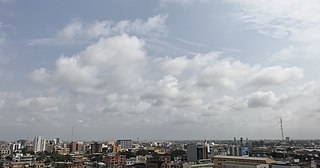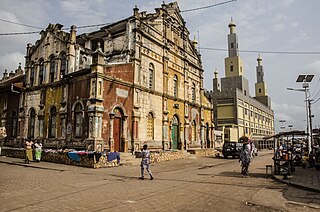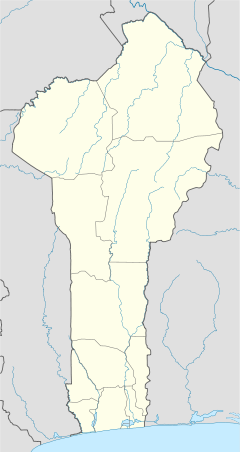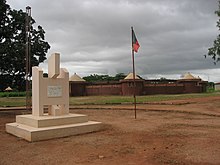
Benin, officially the Republic of Benin, and also known as Dahomey, is a country in West Africa. It is bordered by Togo to the west, Nigeria to the east, Burkina Faso to the north-west, and Niger to the north-east. The majority of its population lives on the southern coastline of the Bight of Benin, part of the Gulf of Guinea in the northernmost tropical portion of the Atlantic Ocean. The capital is Porto-Novo, and the seat of government is in Cotonou, the most populous city and economic capital. Benin covers an area of 114,763 km2 (44,310 sq mi), and its population in 2021 was estimated to be approximately 13 million. It is a small, tropical country. It is one of the least developed, with an economy heavily dependent on agriculture, and is an exporter of palm oil and cotton. Some employment and income arise from subsistence agriculture.

Cotonou is the largest city in Benin. Its official population count was 679,012 inhabitants in 2012; however, over two million people live in the larger urban area.

Porto-Novo is the capital and second-largest city of Benin. The commune covers an area of 110 square kilometres (42 sq mi) and as of 2002 had a population of 223,552 people.

The demographics of Benin include population density, ethnicity, education level, health of the populace, economic status, religious affiliations and other aspects of the population.
Benin possesses railway and road infrastructure, as well as two seaports. Benin currently does not have rail connections to other countries, but new proposals seek to change this.

Bohicon or Gbɔ̀xikɔn is a city in Benin, and a conurbation of Abomey lying 9 kilometres east of the city on the railway line from Cotonou to Parakou and on Benin's main highway RNIE 2 which joins the RNIE 4. The commune covers an area of 139 square kilometres and as of 2012 had a population of 149,271 people.

Borgou is one of the twelve departments of Benin. Borgou borders the country of Nigeria and the departments of Alibori, Atakora, Collines and Donga. The capital of Borgou is Parakou. The department of Borgou was bifurcated in 1999, with its northern territory transferred to the newly created Alibori Department.
Ségbana is a town, arrondissement and commune located in the Alibori Department of Benin. The commune covers an area of 4471 square kilometres and as of 2013 had a population of 89,268 people.
Tchaourou is a commune, arrondissement, and city located in the Borgou Department of Benin, a country in Western Africa, formerly known as Dahomey. It is the birthplace of former Beninese president Yayi Boni. It is 50 kilometres (31 mi) south of Parakou.
The Benin Premier League, also called Championnat National du Bénin in French, is the highest football division in Benin. The league was held in 1969 for the first time. Currently, the initial round is a double round-robin tournament, with 36 clubs being divided in 4 groups, and 9 clubs in each. The last 5 teams of each group, goes to the relegation round, which consists on 2 groups of 10 teams. The first 4 teams of each group goes to the final stage with 16 clubs playing a single round-robin tournament. The winner of this round earns a place in the CAF Champions League.
N'Dali is a city and arrondissement in the north of Benin, and the capital of the Commune of N'Dali in the Borgou Department. The commune covers an area of 3748 square kilometres and as of 2013 had a population of 113,604 people. In 2008 an estimated 16,941 people living in the main town of N'Dali.

The following outline is provided as an overview of and topical guide to Benin:

Christianity is the largest religion in Benin, with substantial populations of Muslims and adherents of traditional faiths. According to the most recent 2020 estimate, the population of Benin is 52.2% Christian, 24.6% Muslim, 17.9% traditionalist and 5.3% follows other faiths or has no religion.

Benin is predominantly a rural society, and agriculture in Benin supports more than 70% of the population. Agriculture contributes around 35% of the country's gross domestic product (GDP) and 80% of export income. While the Government of Benin (GOB) aims to diversify its agricultural production, Benin remains underdeveloped, and its economy is underpinned by subsistence agriculture. Approximately 93% of total agricultural production goes into food production. The proportion of the population living in poverty is about 35.2%, with more rural households in poverty (38.4%) than urban households (29.8%). 36% of households depend solely upon agricultural (crop) production for income, and another 30% depend on crop production, livestock, or fishing for income.

Benin has a total of 578 km (359 mi) of single track, 1,000 mm railway. Rail construction began around 1900, with regular services commencing in 1906; rail operation was taken into government control in 1930.
Benin, officially the Republic of Benin, is a country in Western Africa. It borders Togo to the west, Nigeria to the east and Burkina Faso and Niger to the north; its short coastline to the south leads to the Bight of Benin. Its size is just over 110000 km2 with a population of almost 8500000. Its capital is the Yoruba founded city of Porto Novo, but the seat of government is the Fon city of Cotonou. About half the population live below the international poverty line of US$1.25 per day.

Kandi is a town, arrondissement and commune in the Alibori Department of eastern Benin. Originally a market town, Kandi is now primarily a farming centre. It lies on the nation's main north-south highway, 650 km (400 mi) from Cotonou and 523 km (325 mi) north of Porto-Novo. The town is the capital of the department of Alibori. The commune covers an area of 3,421 km2 (1,321 sq mi) and as of 2013 had a population of 177,683 people. The town itself had a population of 27,227 in 2002.

Dendi is a Songhay language used as a trade language across northern Benin (along the Niger River. It forms a dialect cluster with Zarma and Koyraboro Senni but it is heavily influenced by Bariba.

Niamey, colloquially also known as Niamey Hippodrome, is the main railway station of the city of Niamey, the capital of Niger. Located near the Niamey Racecourse, in Niamey IV borough, is the first station opened in Niger and is part of AfricaRail project.

Fresh (wet) markets occur in most towns and villages in Benin, usually surrounded by large numbers of small shops selling foods, consumer items, imported foods and goods, clothing, household goods, etc. With a large portion of the population producing much of their own food, particularly for starches, open markets are where the diet is rounded out with items not self-produced. For those with higher incomes, more of the food consumed is purchased at market. Most vegetables are in villages and town markets, which usually have a major day, or multiple days, where traders and retailers are active in selling perishables in particular. Fish, meats, staple starch crops, legumes, soy and milk cheeses, fruits, and vegetables are available in the market every week of the year in most places with significant variations in the quantity supplied. Staple crops are usually sold to retailers by wholesalers, who obtain them from the producers. Meat is sold by the butchers who source from the producers. The source of vegetables depends on the season. Regional trade keeps a selection of vegetables available, with price and quantity fluctuations depending on the season. Visits to markets in the Parakou and Nikki areas observed avocados from Lomé in Togo and red onions from Niger. Eastern border markets have many Nigerian traders coming into Benin to purchase fruits and vegetables for sale in Nigeria. Most of these transactions are not captured in either of the countries' statistical records. Vegetables traders/retailers obtain their products either from the intermediary traders or directly at the farm gate if possible. For many items there are unwritten agreements that producers will sell to retailers, not directly to consumers. Intermediaries buy at the farms and transport the products directly to their various market destinations. Women dominate the role of vegetable retailers at these open markets. Vegetable producers market much of their produce in bulk at harvest time because of the highly perishable nature of their products. In general, producers conduct all of their sales immediately after harvest. The long marketing channel of vegetables in the larger peri-urban and urban areas involves several types of intermediaries, from local traders to wholesalers. Studies by INRAB have shown that producers are more inefficient in marketing than in production. There is a lack of market participation of farmers and current barriers to entry by farmers limit their access to markets.


















